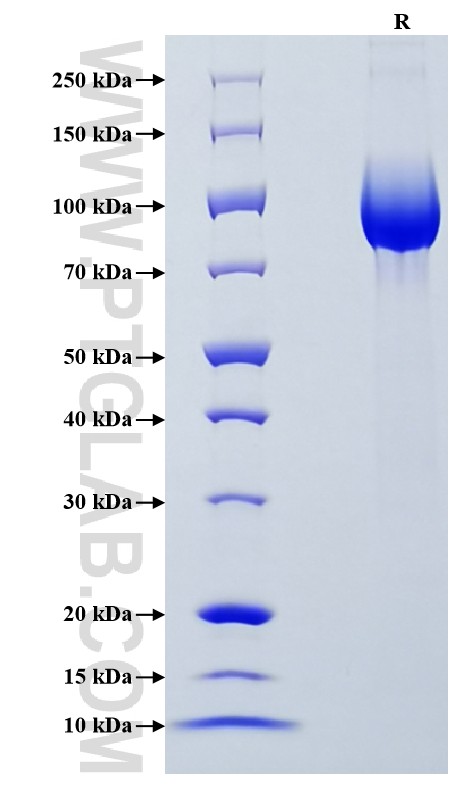Recombinant Human GP2 protein (rFc Tag)
种属
Human
纯度
>90 %, SDS-PAGE
标签
rFc Tag
生物活性
未测试
验证数据展示
产品信息
| 纯度 | >90 %, SDS-PAGE |
| 内毒素 | <0.1 EU/μg protein, LAL method |
| 生物活性 |
Not tested |
| 来源 | HEK293-derived Human GP2 protein Val29-Asn512 (Accession# P55259-1) with a rabbit IgG Fc tag at the C-terminus. |
| 基因ID | 2813 |
| 蛋白编号 | P55259-1 |
| 预测分子量 | 80.1 kDa |
| SDS-PAGE | 80-120 kDa, reducing (R) conditions |
| 组分 | Lyophilized from 0.22 μm filtered solution in PBS, pH 7.4. Normally 5% trehalose and 5% mannitol are added as protectants before lyophilization. |
| 复溶 | Briefly centrifuge the tube before opening. Reconstitute at 0.1-0.5 mg/mL in sterile water. |
| 储存条件 |
It is recommended that the protein be aliquoted for optimal storage. Avoid repeated freeze-thaw cycles.
|
| 运输条件 | The product is shipped at ambient temperature. Upon receipt, store it immediately at the recommended temperature. |
背景信息
Pancreatic secretory granule membrane major glycoprotein (GP2) is the most abundant membrane component of zymogen granules secreted by pancreatic acinar cells. GP2 associates with the plasma membrane via glycosylphosphatidylinositol (GPI) linkage. It is released from the membrane of mature zymogen granules by an enzymatic mechanism. GP2 plays a role in defense against adhesive and invasive commensal bacteria during intestinal inflammation. GP2 is preferentially expressed in acinar cell carcinomas of the pancreas but the glycoprotein can rarely also be expressed in a variety of other tumor entities. The apparent molecular weight of GP2 is 70-100 kDa, which is larger than the calculated molecular weight, due to glycosylation.
参考文献:
1. Scheele, G A et al. Pancreas vol. 9,2 (1994): 139-49. 2. Fukuoka, S et al. Proceedings of the National Academy of Sciences of the United States of America vol. 88,7 (1991): 2898-902. 3. Kurashima, Yosuke et al. Nature communications vol. 12,1 1067. 16 Feb. 2021. 4. Uhlig, Ria et al. Pathology, research and practice vol. 238 (2022): 154123.
